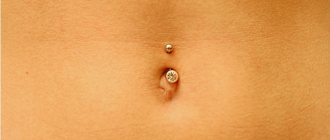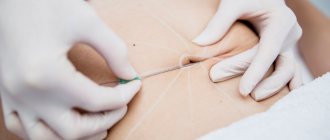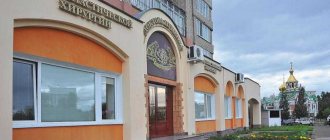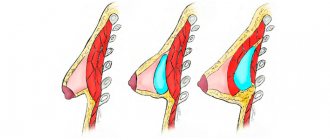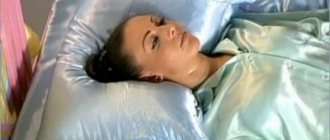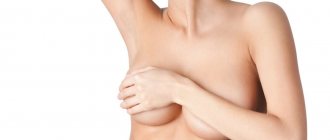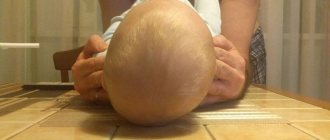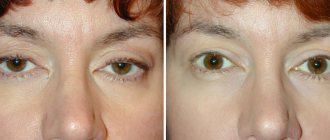One of the types of abdominoplasty is navel surgery. This operation is otherwise called umbilicoplasty. Its main task is to correct defects associated with the navel. Such defects may include any changes in size, shape, position that differ from the aesthetic ideal and cause psychological and sometimes physiological discomfort to the patient. Umbilicoplasty will effectively eliminate any aesthetic disturbances and restore your former satisfaction with yourself and your body.
This type of surgery is more cosmetic. This correction is quite young, but it is becoming more popular year by year. Low cost and effective results attract patients who are dissatisfied with the aesthetics of the navel and peri-umbilical area. The operation is in great demand among women who need navel surgery after childbirth. There are no medical indications for this operation, only aesthetic ones. Correction can be prescribed to both men and women, regardless of age, starting from adulthood.
Plastic surgery can be done at any time, but if a woman is breastfeeding, she must wait until lactation ends.
Navel surgery (umbilicoplasty)
After pregnancy or sudden weight loss, it is not always possible to maintain a neat navel, because stretch marks and excess folds may appear. Such imperfections prevent patients from enjoying their figure. A plastic surgeon will help correct the deficiency through umbilicoplasty or navel surgery. This operation is considered small in scope, but can give a good result that will please the patient.
Patients usually seek belly button surgery after significant weight loss, multiple pregnancies, unsuccessful abdominal surgery, or a belly button piercing that has caused an allergic or inflammatory reaction in the body, leaving noticeable scars on the skin.
Umbilicoplasty: how to fix an ugly navel?
Even with an ideal figure, it is not easy to undress on the beach, in the pool, in the sauna, or simply wear revealing clothes if you are unhappy with your navel and consider it ugly. How to fix the situation?
Umbilicoplasty is a plastic surgery to correct the navel, which can eliminate almost any of its defects. The only effective way today to change the size, shape or general appearance of this part of the body.
The standard of beauty is a neat funnel-shaped navel, which lies on the midline of the abdomen, at the same distance from the pubis and the xiphoid process of the chest. What if it is too wide or deep? Or, on the contrary, does it protrude strongly above the surface of the abdomen? TecRussia.ru talks, and plastic surgeons share their experience.
↑ Indications for umbilicoplasty
One of the unique features of the navel is that, unlike the shape of the nose, eye color and other details of appearance, it is not inherited. Its initial “parameters” depend on the treatment of the umbilical cord at birth, care of the umbilical wound - problems often arise already at this stage. With age, new unfavorable factors may appear: umbilical hernia, unsuccessful piercing, consequences of injuries, sudden weight fluctuations (especially during pregnancy), etc.
There are no mandatory medical indications for navel surgery. Its shape does not have any effect on the state of health, we are talking only about the aesthetic wishes of the patient. As a rule, people who have a navel come for umbilicoplasty:
- protrudes above the level of the abdomen, which often occurs due to careless or incorrect ligation of the umbilical cord at birth;
- too deep - a lot of specific secretions accumulate in it, which is sometimes difficult to clean out, which creates the effect of a dirty body;
- wide, stands out strongly even against the background of a flat and toned stomach;
- stretched due to pregnancy or significant weight gain, sagging with age, after sudden significant weight loss, deformed or completely lost during abdominal operations;
- incorrectly, asymmetrically positioned
| Photo 1 – this is what a non-standard shaped navel may look like: | |
In addition, this operation is indicated if:
- The patient has an umbilical hernia, which makes the navel large, round and convex. Umbilicoplasty is combined with surgery to remove the hernia itself (hernioplasty);
- the skin around the navel is torn, covered with scars after unsuccessful piercing or injury;
- The patient is not satisfied with the condition of her navel after a previous tummy tuck.
↑ How is navel correction performed?
Umbilicoplasty takes from 30 to 90 minutes and is usually performed under local anesthesia (optionally, general anesthesia is also possible). It is often performed in combination with abdominoplasty or abdominal liposuction. What exactly the surgeon will do depends on the characteristics of the defect that is planned to be eliminated:
- to change the aesthetic parameters of the navel, an incision is made, after which the desired depth, size and shape are formed, most often in the form of a classic vertical fold;
- if it is necessary to remove a convex navel, excess skin is excised, and the remaining tissue is immersed deep into the skin fold;
- the most difficult option is reconstruction of the lost navel. It is made from a skin flap on the abdomen.
The incisions are made in such a way that the postoperative scars are hidden in the umbilical fold and remain invisible from the outside.
| Photo 2.3 – before and after umbilicoplasty: | |
↑ Rehabilitation after umbilicoplasty
Recovery after navel surgery does not take much time. The patient almost always goes home on the day of surgery, and after a few days he can carry out normal daily activities, with the exception of significant physical activity.
There may be hematomas around the corrected navel, which will go away on their own in 1-2 weeks. It is imperative to follow the surgeon’s recommendations for caring for the operated area to avoid complications or infection. Until the sutures are completely healed after umbilicoplasty, going to the pool, sauna, solarium, or beach is excluded. The final result can be assessed in 1.5-2 months.
| Photo 4 – before and after umbilicoplasty for umbilical hernia: | |
| Photo 5 – navel surgery combined with abdominoplasty: | |
↑ Contraindications for navel correction
There are no specific factors that exclude umbilicoplasty. But, like other surgical interventions, it is contraindicated in the following cases:
- Oncological diseases.
- Blood clotting disorders.
- Diabetes.
- Acute infectious, febrile conditions or exacerbations of chronic diseases.
↑ Price of umbilicoplasty
The cost of navel correction depends on several nuances: what kind of defect the surgeon will work with, what level it is, what the clinic’s pricing policy is, etc. If the operation is performed as a complex (for example, abdominoplasty), its relative cost will be significantly lower.
| Umbilicoplasty – prices in Moscow (RUB): | |
| Average | 55.904 |
| Minimum | 9,800 rub. (clinic "InterMedCenter") |
| Maximum | 298,000 rub. (Dr. Teplyashin Alexander Sergeevich) |
| * all prices listed are synchronized with the TecRussia.ru price list database and are current as of the current date. | |
↑ Experts' opinions
For professional comments, we turned to our experts - the capital's leading plastic surgeons. Here's what we asked:
- How often and for what reasons do you perform umbilicoplasty?
- Is it true that a navel piercing can lead to significant problems in this area?
| Ageshina Svetlana Evgenievna leading plastic surgeon at the Beauty Line clinic: Navel surgery is a fairly popular procedure in our clinic. They are mainly treated for an inverted navel, umbilical hernia, deformity and scars. We would like to draw the attention of girls that navel piercing can really cause serious complications - purulent inflammation and they occur in this area much more severely than on other parts of the body, leaving behind unaesthetic scars. |
| Savitsky Stanislav Stanislavovich leading plastic surgeon at the Studiomed clinic: Such plastic surgery is often performed in our clinic in the presence of umbilical hernias, stretch marks of the navel skin during pregnancy and after. Navel piercing, even if successful over time, can also become an indication for plastic surgery, when the skin around the barbell stretches and thins, deformation of the fold occurs, this is especially noticeable when the barbell is no longer worn. The operation is not complicated, it takes about an hour, during which time excess skin in this area is excised and the navel is immersed in a natural fold. Thus, a beautiful aesthetic shape of a navel of medium depth is modeled. Compared to correction, surgery to restore a completely lost navel is more difficult. |
| Kosinets Vladimir Alexandrovich Doctor of Medical Sciences, leading plastic surgeon at the GEMC Aesthetic Clinic: The operation is due to the need to create an aesthetically attractive appearance of the navel, which is an integral part of a harmonious abdomen - changes in it can become an obstacle to wearing open clothes or spending time comfortably on the beach. As a rule, umbilicoplasty involves the elimination of an umbilical hernia, which was the direct cause of the deformation, excessive protrusion of the navel, or the removal of excess overhanging skin. Access is carried out directly through the navel, so traces of the intervention in the future will be almost invisible. |
What is navel surgery (umbilicoplasty)?
Ubilicoplasty is a plastic surgery aimed at correcting the navel by excision of tissue and removal of excess skin. Belly button surgery is considered a simple operation with little rehabilitation. It can be performed either locally or as part of abdominoplasty or abdominal liposuction. The scope of the intervention is determined by the plastic surgeon after consultation, having carefully examined the condition of the patient’s tissues and listened to his wishes.
Sometimes, to obtain a good result, it is necessary to combine navel correction with the removal of local fat deposits (abdominal liposuction) and the removal of the skin-fat apron by liposuction. In such cases, local correction of the navel will not bring the desired effect, so it is worth listening to the opinion of a specialist and performing the entire scope of the operation.
NAMLIK CORRECTION IN THE PIROGOV CLINIC IS AN OPERATION IN THE BEST PLASTIC SURGERY CLINIC IN ST. PETERSBURG.
*according to the ratings of the portals “Doctor Peter” and “Fontanka.ru” in 2021. Read more.
We decided to call our complex of operations “Venus Silhouette”. The technique is suitable for patients with excess body weight and fat deposits throughout the body: on the anterior abdominal wall, sides, back and, of course, the abdomen - with a pronounced “apron”.
During the operation, we not only rid the patient of the “apron”, but also create a thin waist using massive liposuction. Liposuction is carried out in a circle: we remove fat from the anterior abdominal wall, side surfaces, back, and remove excess volume under the breasts in the ribs.
Fat on the anterior abdominal wall is very difficult to manage on your own with diet and exercise. The same applies to the side surfaces, the so-called flanks. But these areas can be corrected using liposuction and supplemented by excision of excess skin and subcutaneous fat, as we do with conventional abdominoplasty.
Complex “Silhouette of Venus”, before and after surgery. Plastic surgeon Maria Egorova (Frau Klinik):
This is not a public offer. There are contraindications. Before use, consultation with a specialist is required.
This is not a public offer. There are contraindications. Before use, consultation with a specialist is required.
Pros and cons of combining abdominoplasty with liposuction
Plus:
in one operation the patient receives a slender, beautiful silhouette (from the chest to the pubis/buttocks).
Minus:
The volume of the operation is quite large, so recovery may take a little longer than rehabilitation after a conventional abdominoplasty.
Who is not suitable for this set of operations?
Those who do not have local deposits in the areas listed above and, accordingly, do not need liposuction in these areas. The remaining contraindications are general for surgical operations.
Can everyone create a thin waist?
With this operation, visceral fat (fat located between the abdominal organs)
. It is impossible to remove it and reducing the size of the belly with a large amount of visceral fat is possible only through the natural process of losing weight.
Thus, for patients with abdominal obesity, when there is no “apron” and the stomach, on the contrary, is stretched tightly, this operation cannot be performed - plastic surgeons remove only subcutaneous fat deposits.
There are cases when the patient is overweight, but at the same time she has an excess of subcutaneous fat, and not very much abdominal fat. Then you can perform this operation and get the most slender and beautiful silhouette.
Complex “Silhouette of Venus”, before and after surgery. Plastic surgeon Maria Egorova (Frau Clinic):
This is not a public offer. There are contraindications. Before use, consultation with a specialist is required.
Performing an operation
The operation takes about three hours. First, the areas of fat deposition are marked, then the midline of the abdomen and the volume of the excised apron.
The operation begins with liposuction. Since liposuction is performed both front and back, first the patient is placed on her stomach and the entire back part is worked on: the back, flanks, as well as the area above the buttocks - this is a very important area for creating a pronounced waist.
Then we turn the patient onto her back and perform liposuction of the anterior abdominal wall and sides.
Finally, we excise the skin and subcutaneous fat with a full flap, performing abdominoplasty.
In order for the transition area between the pubis and abdomen to look natural, at the stage of planning the operation, the doctor evaluates the thickness of the subcutaneous fold in the area of the tissue being moved. If necessary, pubic liposuction is performed.
The combination of these operations is also good because after removing a large amount of fat using liposuction, a larger amount of excess skin is released. And it becomes possible to remove this excess as much as possible during abdominoplasty, making the stomach as flat as possible.
If necessary, during surgery, diastasis can be eliminated, due to which the waist narrows even more noticeably.
Theoretically, it is possible to add lipofilling of the buttocks, but then the volume of the operation will become too large and the rehabilitation too difficult.
I also do not consider it advisable to combine this operation with mammoplasty - for the same reasons. However, the decision is made individually with each patient. For small volumes of excised tissue, it is possible to combine operations with mammoplasty.
Thinner, even thinner!
In some countries, additional waist narrowing is achieved using a technique in which not only the rectus abdominis, but also the oblique abdominal muscles are sutured. However, this cannot always be done, since women with increased body weight have increased intra-abdominal pressure. Their fat is located in excess and between the organs, and if the lateral muscles are sufficiently sutured, physiological problems may arise after the operation.
Stitching the oblique muscles is not entirely physiological, but in pursuit of beauty, women are often ready to sacrifice physiology. I consider this technique redundant and do not use it.
Navel shape
The navel is reshaped during abdominoplasty. As a rule, it turns out oval in shape, retracted, as close as possible to its natural appearance.
The skin at the bottom of the navel remains its own, but the area around the navel is cut out and all the skin above it is repositioned. A hole is made in this displaced skin. The navel “on a stalk”, which remains on our anterior abdominal wall, is pulled into this hole and sewn in. The edges of the navel are newly formed, and the inner part is its own. But since the inside is practically invisible, the shape as a whole is different.
Scar shape and size
Almost always the scar can be made low. So as to hide it in the underwear area. The exception is for patients with a certain anatomical structure, when it is necessary to raise the scar higher than desired.
The length of the scar depends on the amount of excess skin we excise. That is, in patients with large body weight, the scar will be longer.
It is very rare to add a vertical component (incision) during abdominoplasty, when there are stretch marks at the top or there is a vertical scar after a previous operation. Or with a certain structure - such an excess of skin that does not allow all the excess tissue to be pulled down into a horizontal scar. This is discussed during a face-to-face consultation.
Rehabilitation
At first, for about two weeks, patients may find it difficult to straighten up. Especially if the diastasis was sutured. This is normal, 99% of women experience such difficulties after abdominoplasty.
Childbirth after abdominoplasty
In the first six months after the operation, we strongly do not recommend becoming pregnant, as internal scars should form. Otherwise, during pregnancy there is a risk of divergence of the abdominal muscles and diastasis will reappear. The skin may also re-stretch, and excess subcutaneous fat will reappear due to weight gain.
The risk is only aesthetic and does not affect the course of pregnancy in any way. However, we encourage patients to come for surgery at a time in their lives when pregnancy is definitely not planned in the near future.
Complex “Silhouette of Venus”, before and after surgery. Plastic surgeon Maria Egorova (Frau Clinic):
This is not a public offer. There are contraindications. Before use, consultation with a specialist is required.
This is not a public offer. There are contraindications. Before use, consultation with a specialist is required.
To communicate with patients who have undergone abdominoplasty, come to our forum in the Abdominoplasty
Navel surgery after childbirth.
Many young mothers note that after childbirth, the navel became deformed and ceased to satisfy them. Due to tissue tension, the navel may droop or develop an unsightly fold above the umbilical ring. In this case, it is recommended to perform a navel correction and eliminate the imperfections that the woman does not like. As a rule, patients who, in addition to navel surgery, require mini-abdominoplasty, abdominoplasty, elimination of diastasis, or umbilical hernia repair, turn to a plastic surgeon for help. The defects can be corrected during one simultaneous operation, which will give the desired result and return the patient to a flat stomach.
Reviews about umbilicoplasty
As patients note, the full result can be assessed several months after surgery (this time is enough for complete tissue regeneration). As a rule, the rehabilitation period proceeds according to the following scenario: the primary results are noticeable on the 10th day, when the swelling subsides and the navel begins to take on a natural shape; after 2 months the seam turns white and becomes invisible.
More than 90% of patients turn to a surgeon for aesthetic reasons, due to dissatisfaction with the size, shape, and position of the navel. These defects cause psychological and, less often, physiological discomfort. According to patients, umbilicoplasty restores satisfaction with oneself and one’s body, and increases the level of self-esteem.
Indications for surgery.
Indications for navel surgery are aesthetic dissatisfaction with the shape of the umbilical ring, which was this way by nature or acquired this appearance after pregnancy or sudden weight loss. There are also consequences of unsuccessful piercing or extensive surgery on the abdominal wall, which affect the shape of the navel. Thanks to modern methods of aesthetic medicine, it is possible to correct even complex cases. Over time, neat scars will form at the site of the incisions, which over time become almost invisible if the patient has good tissue scarring.
How is umbilicoplasty performed?
Before the operation begins, the navel is treated with an antiseptic and the patient is immersed in a state of anesthesia. The type of anesthesia (local/general) is selected depending on the complexity of the operation. The surgeon makes incisions and creates the required length, shape and size of the umbilical ring. If there are appropriate indications, excess tissue is excised and a classic longitudinal fold is formed. If umbilicoplasty is combined with hernia removal, the surgeon first corrects the pathology and strengthens the abdominal wall, and then sutures the navel. At the end of the operation, stitches and a sterile dressing are applied.
Preparing for surgery.
After the date of the operation has been set, it will be necessary to undergo preoperative tests, the list of which depends on the anesthesia under which it is decided to perform the operation - general or local. If ubilicoplasty is supposed to be of small volume, then it can be performed under local anesthesia. If the navel correction is performed as part of a full abdominoplasty, then the operation will require a full Standard C examination, which includes laboratory tests of blood, urine, biochemical blood test, X-ray, ECG, as well as the conclusion of a general practitioner and anesthesiologist.
Progress of the operation.
The scope of the operation depends on the necessary manipulations. If the patient is indicated for local correction of the navel, then the plastic surgeon will excise the tissue and form a neat umbilical ring. In this case, as a rule, 1.5 hours is enough, after which the specialist applies stitches.
If the scope of the operation involves performing abdominoplasty and suturing diastasis, then the operation will last about 4 hours. After stitches are applied, special shapewear is put on the patient’s body.
Rehabilitation period.
The rehabilitation period depends on the extent of the operation performed. If only the navel correction was carried out, then the postoperative period passes easily, and after a month and a half a thin scar forms at the site of the incisions.
If the operation included excision of the skin-fat apron, removal of diastasis and formation of a new navel, then the rehabilitation period includes wearing corrective underwear for 2-3 months, which is necessary for favorable tissue healing.
During the rehabilitation period, it is necessary to refrain from active physical activity, visiting the bathhouse, swimming pool, sauna and solarium. It is necessary to return to exercise in the gym after consultation with a plastic surgeon.
Rehabilitation period after umbilicoplasty
Navel plastic surgery is a simple operation, so the rehabilitation period is short - on average 2 weeks (more precise dates are determined by the doctor on an individual basis). If umbilicoplasty was performed as an independent operation, then the patient can go home a few hours after the plastic surgery. During the entire rehabilitation period, it is recommended to wear compression garments, avoid physical activity and direct heat exposure, and postpone visiting the sauna, bathhouse, swimming pool, or solarium.
